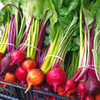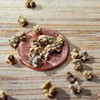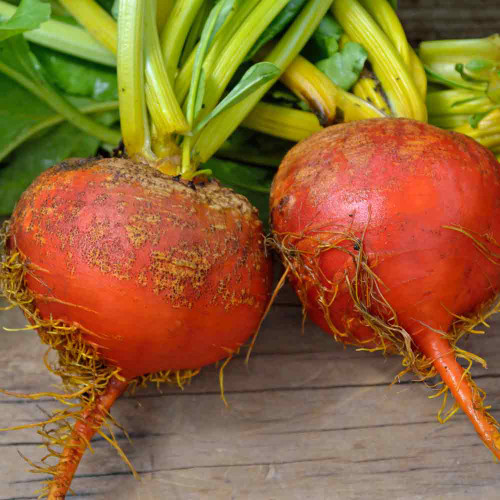Rainbow Beet Mix Seeds - (Beta vulgaris)
- SKU:
- V1535
- Seed Count:
- Approx 150 seeds per pack
- Days to Maturity:
- 35 days for baby leaf tops; 55 days for edible roots
- Days to Germination:
- 5-10 days @ 55-80F
- Plant Spacing:
- 4-6"
- Light Preference:
- Full sun
- Soil Requirements:
- Sandy loam
- Status:
- Heirloom, Non-Hybrid, Non-GMO seeds
Description
Rainbow Beet Mix - Full Spectrum of Colors and Shapes
You'll discover a living rainbow of color in your garden bed, pulling up a different jewel with every beet you harvest—one day a classic deep ruby, the next a sunny gold, and the day after, a stunning candy-striped treasure. That is the joy of planting this storybook mix, a living treasure hunt we created for the gardener who delights in variety and surprise.
This blend features five distinct, open-pollinated beet varieties, each one specifically selected for its reliable performance and exceptional flavor, ensuring every colorful gem you unearth is as delicious as it is beautiful. Beyond the painter's palette of colors, you'll also find a diversity of forms, from classic globe shapes to larger, elongated roots. Many of the varieties in this mix also produce delicious, tender greens, providing a bonus harvest of nutritious leaves for salads and sautés long before the roots are ready.
History
The story of the beet begins not in a garden, but along the wild coastlines of the Mediterranean. Early civilizations there foraged the leaves of the sea beet, the humble ancestor of the sweet, colorful roots we prize today. Over centuries, as cultivation spread through the Fertile Crescent around 2000 BC, farmers began selecting plants for their larger, more flavorful roots, beginning a long and slow process of domestication.
Ancient Greek scholars, including the botanist Theophrastus, were among the first to formally document different beet varieties. Physicians like Hippocrates valued beet leaves for their medicinal properties, using them to aid digestion and as a poultice for skin inflammations and sores. The Romans, however, were instrumental in spreading the beet across their empire, leaving behind detailed records on cultivation and a variety of recipes that speak to its importance in their cuisine. This long, rich history connects every beet in this mix to thousands of years of cultivation, selection, and use across the ancient world.
Uses
You'll find roasting is one of the best ways to prepare beets, as it concentrates their natural sugars and results in a tender, caramelized vegetable. For an extra dimension, try slow-roasting them on a charcoal grill. This technique infuses the beets with a subtle smokiness that complements their sweetness. Simply scrub the beets, coat them in olive oil, wrap them in foil, and place them on the cooler side of a medium-hot grill for 45-60 minutes, or until tender.
Beyond roasting, the earthy sweetness of these beets provides a beautiful contrast to tangy goat cheese, bright vinaigrettes, and the crunch of toasted nuts in fresh salads. The vibrant hues of this mix are also perfect for creating eye-catching juices and smoothies, adding a nutritious and colorful boost. For a creative twist in the kitchen, try incorporating shredded beets into your favorite brownie or cake recipes; they add moisture, a subtle sweetness, and a surprising depth of color.
For long-term enjoyment, these beets are excellent for both canning and pickling. Their flavor and beautiful colors hold up exceptionally well, whether you are simply preserving them in jars or creating unique infusions with herbs and spices. From a classic sweet and tangy pickle to a more adventurous spicy, garlicky brine, the mild, earthy flavor of these beets readily absorbs the character of your chosen recipe.
Companion Planting
Beets benefit from being planted near a variety of helpful neighbors. Good companions include bush beans, onions, and various brassicas like kale and cabbage, which can help with pest protection and nutrient sharing. Lettuce also makes a great companion, as its broad leaves can help shade the soil and keep the beetroots cool.
However, beets should not be planted in close proximity to pole beans or chard, as they can hinder each other's growth.
Planting and Growing Tips
For the best results, plant your beets in rich, well-drained soil. If your soil is heavy with clay, it's wise to amend it with a generous amount of compost or well-rotted manure before planting. This improves drainage and aeration, creating a looser soil structure that allows the beetroots to swell without restriction. Soaking your seeds in water for about 12 hours before planting can also give them a head start on germination.
Like most root vegetables, beets develop their sweetest flavor and best color in full sun, so choose a spot that receives at least six hours of direct light each day.
Sow your beet seeds about half an inch deep and one to two inches apart. After the seedlings have emerged and developed their first true leaves, it is crucial to thin them to a final spacing of three to four inches. This may feel difficult, but giving each plant adequate space prevents competition for water and nutrients, which is essential for developing well-formed, sizable roots.
Maintaining consistent moisture is the key to producing sweet, tender beets. Water deeply and regularly, especially during hot and dry spells, to keep the soil evenly moist but never waterlogged. Applying a layer of mulch, such as straw or shredded leaves, around your plants is an excellent way to help conserve soil moisture and suppress weed growth. For a continuous harvest throughout the season, consider succession planting, sowing a new batch of seeds every few weeks.
Harvesting Tips
You can begin harvesting your beets when they are about the size of a golf ball; at this stage, they are incredibly tender and flavorful, but can still be harvested up to three or four inches in diameter. For the best quality, it's always best to harvest during the cool of the morning. This ensures the beets are crisp and full of moisture.
If you enjoy beet greens, you can harvest a few of the outer leaves from each plant as they mature. Be sure to leave the inner leaves intact so the plant can continue to nourish the developing root.
Beets store exceptionally well. After harvesting, prepare them for storage by gently twisting off the leaves, leaving about an inch of the stem attached to prevent the roots from "bleeding" their color. Trim the long taproot, and carefully brush off any loose soil, but do not wash them, as moisture can encourage rot. You can store them in a box filled with damp sand or peat moss in a cool basement or garage, which helps to maintain the humidity they need to stay firm and fresh.
Learn More
From the soil to the seed to the food you eat - we'll help you grow your best garden!













